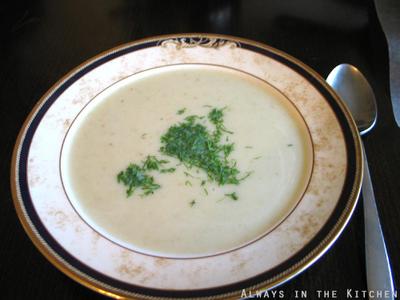There is always something that seems a little on the fancy side, when it comes to creamy soups - ones that didn't come from a can, that is. They tend to be loaded with butter and cream, and have a silky texture that is both comforting and lulling. They make me think of French restaurants, and indeed, that is often where I have them.
Every once in a while, though, I bother to make my own. It isn't difficult, and it only takes about an hour of lazy-work, and there aren't that many ingredients required. Ever since I picked up a fennel bulb recently - to make a roasted fennel and Italian sausage pizza (no pictures, I'm afraid) - I've been thinking about the pile of plump, round, white and brightly green fennel in my local greengrocer. Coincidentally enough, I've also had a recipe for fennel soup beckoning me from a cookbook that I've had for some years. It does call for a modest amount of butter, but needs only plain milk rather than cream, and uses not only the flesh of the fennel bulb, but also the roasted seeds and the fronds from the top as a garnish.
Today, since breakfast was light and dinner will be late, we decided to make lunch - a rarity on the weekend. A quick trip up the street to pick up some fennel, and then back to the stove to begin the magical transformation into soup.

I won't lie to you - there is a little chopping involved. Fennel, happily, is very easy to chop. You simply remove the heavy, stringy, outer layer, cut in half pole-to-pole, and then slice half-moon pieces as easily as cutting an onion. With a little practice, even that doesn't take long, and you're practically done at that point.
Fennel Soup
Adapted from the Australian Women's Weekly Fruit & Vegetable Cookbook.
Serves 4

2 tablespoons butter
2 medium bulbs of fennel, trimmed and sliced
1 medium onion, peeled and diced
1 medium apple, peeled, cored, and diced
1 clove of garlic, crushed
3 cups of light chicken stock
1 cup of milk
2 teaspoons of fennel seeds, toasted
Remove the stalks from the fennel and reserve for another use or discard. Save some of the fronds for garnish - set them aside.
In a medium-large pot, melt the butter. Add the sliced fennel, the onion and apple, and stir and cook until the onion starts to turn translucent and the volume of vegetable matter reduces in the pot (softens enough to compact). Add the stock, and bring to a boil. Reduce the heat and simmer for 15 minutes, or until the chunkiest bit of fennel is tender to the tip of a knife. Allow to cool slightly while you pour two teaspoons of fennel seeds into a small frying pan, and toast over a medium heat until they start to turn colour and smell fragrant. Be careful not to burn them.
When the fennel is tender, puree the soup in batches (add the toasted fennel seed to the first batch) - be careful when pureeing hot soup - never fill your blender more than half-way up. If you have an immersion blender, that would also work. Once all of the soup is pureed, return it to the pot on the stove. Add the milk and stir well. Taste the soup to see if you need to add any salt. The chicken stock may have added enough, but if not you can add a little pinch of salt now, and stir it through. Heat the soup gently until it is warmed through, but be careful not to let it boil. Top individual bowls with a good pinch of chopped fennel fronds, and a grinding of black pepper. Serve with bread to mop up every last bit of soup from your bowl.
So simple. Yet still, it feels a little fancy.
 During the above stage, the top-crust was partially rolled out and resting in the freezer. After I got the filling in and smoothed out, I took the top-crust out, let it sit on the counter for a moment, and then finished rolling it out.
During the above stage, the top-crust was partially rolled out and resting in the freezer. After I got the filling in and smoothed out, I took the top-crust out, let it sit on the counter for a moment, and then finished rolling it out. I am a compulsive pie-crimper. I know no other way. I cannot bear to do the fork-pressed edges, because I can feel my mother's laziness-accusing gaze from the heavens. So, I crimp all pies. Even lattice-tops.
I am a compulsive pie-crimper. I know no other way. I cannot bear to do the fork-pressed edges, because I can feel my mother's laziness-accusing gaze from the heavens. So, I crimp all pies. Even lattice-tops. A teensy bit of egg-wash on the top of the pie gives it a lovely golden colour. I start my filled pies at 450 F for ten minutes, then reduce to 350 F to finish baking - 30 - 40 minutes, usually.
A teensy bit of egg-wash on the top of the pie gives it a lovely golden colour. I start my filled pies at 450 F for ten minutes, then reduce to 350 F to finish baking - 30 - 40 minutes, usually.











